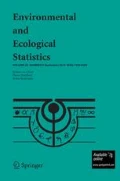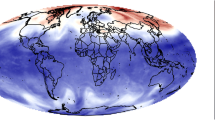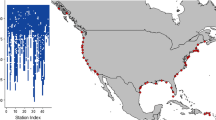Abstract
This paper develops a process-convolution approach for space-time modelling. With this approach, a dependent process is constructed by convolving a simple, perhaps independent, process. Since the convolution kernel may evolve over space and time, this approach lends itself to specifying models with non-stationary dependence structure. The model is motivated by an application from oceanography: estimation of the mean temperature field in the North Atlantic Ocean as a function of spatial location and time. The large amount of this data poses some difficulties; hence computational considerations weigh heavily in some modelling aspects. A Bayesian approach is taken here which relies on Markov chain Monte Carlo for exploring the posterior distribution.
Similar content being viewed by others
References
Barnes, S.L. (1964) A technique for maximizing details in numerical weather map analysis. Journal of Applied Meteorology, 3, 396–409.
Berry, R.P. and Ver Hoef, J. (1996) Blackbox kriging: spatial prediction without specifying variogram models. Journal of Agricultural, Biological, and Ecological Statistics, 1, 297–322.
Besag, J. (1986) On the statistical analysis of dirty pictures. Journal of the Royal Statistical Society (Series B), 48, 259–302.
Besag, J. and Green, P.J. (1993) Spatial statistics and Bayesian computation (with discussion). Journal of the Royal Statistical Society (Series B), 16, 395–407.
Besag, J., Green, P.J., Higdon, D.M. and Mengersen, K. (1995) Bayesian computation and stochastic systems (with discussion). Statistical Science, 10, 3–66.
Brown, P.J., Le, N.D. and Zidek, J.V. (1994) Multivariate spatial interpolation and exposure to air pollutants. The Canadian Journal of Statistics, 22, 489–509.
Cane, M.A., Clement, A.C., Kaplan, A., Kushnir, Y., Pozdnyakov, D., Seager, R., Zebiak, S.E. and Murtugudde, R. (1997) Twentieth-century sea surface temperature trends. Science, 275, 957–60.
Cressie, N. A.C. (1991) Statistics for Spatial Data. Wiley-Interscience.
Cummings, J.A., Szczechowski, C. and Carnes, M. (1997) Global and regional ocean thermal analysis systems. Marine Technical Society Journal, 31, 63–75.
Fukumori, I. and Malanotte-Rizzoli, P. (1995) An approximate Kalman filter for ocean data assimilation: an example with an idealized Gulf Stream model. Journal of Geophysical Research, 100, 6777–93.
Gelfand, A.E. and Smith, A.F.M. (1990) Sampling based approaches to calculating marginal densities. Journal of the American Statistical Association, 85, 389–409.
Geyer, C.J. (1992) Practical Markov chain Monte Carlo (with discussion). Statistical Science, 7, 473–511.
Gilks, W.R., Clayton, D.G., Spiegelhalter, D.J., Best, N.G., McNeil, A.J., Sharples, L.D. and Kirby, A.J. (1993) Modelling complexity: Applications of Gibbs sampling in medicine (disc: P53-102). Journal of the Royal Statistical Society (Series B), 55, 39–52.
Guttorp, P., Meiring, W. and Sampson, P.D. (1994) A space-time analysis of ground-level ozone data. Environmetrics, 5, 241–54.
Handcock, M.S. and Wallis, J.R. (1994) An approach to statistical spatial-temporal modelling of meteorological fields (with discussion). Journal of the American Statistical Association, 89, 368–90.
Isaaks, E.H. and Srivastava, R.M. (1990) An Introduction to Applied Geostatistics, Oxford University Press, New York.
Johnson, V.E. (1996) A coupling-regeneration scheme for diagnosing convergence in markov chain monte carlo algorithms. Technical Report 96-05. Institute of Statistics and Decision Sciences, Duke University, North Carolina.
Journel, A.G. and Huijbregts, C.J. (1979) Mining Geostatistics. Academic Press, San Diego.
Levitus, S. (1982) Climatological atlas of the world ocean, Professional Paper 13, NOAA, US Government Printing Office, Washington, DC.
Levitus, S. (1994) World ocean atlas 1994 CD-ROM sets. Informal Report 13. National Oceanographic Data Center, Washington, D.C.
Lozier, M.S., Owens, W.B. and Curry, R.G. (1995) The climatology of the North Atlantic. Progress in Oceanography, 36, 1–44.
Matérn, B. (1986) Spatial Variation (Second Edition). Springer-Verlag, New York.
Matheron, G. (1963) Principles of geostatistics. Economic Geology, 58, 1246–66.
Meiring, W., Monsetiez, P., Sampson, P.D. and Guttorp, P. (1996) Developments in the modelling of nonstationary spatial covariance structure from space-time monitoring data. In E.Y. Baafi and N. Schofield (eds), Proceedings of the 5th International Geostatistics Congress, Kluwer.
Miller, R.N. (1986) Toward the application of the Kalman filter to regional open ocean modelling. Journal of Physical Oceanography, 16, 72–86.
Le, N.D. and Sun, J.V.Z. (1997) Bayesian multivariate spatial interpolation with data missing by design. Journal of the Royal Statistical Society (Series B), 59, 501–10.
Omre, H., Sølna, K. and Tjelmeland, H. (1993) Simulation of random functions on large lattices. In A. Soares (ed.), Geostatistics Troia '92, pp. 179–199.
Parrilla, G., Lavin, A., Bryden, H., García, M. and Millard, R. (1994) Rising temperatures in the subtropical North Atlantic Ocean over the past 35 years. Nature, 369, 48–51.
Ripley, B.D. (1981) Spatial Statistics, John Wiley & Sons, New York.
Sampson, P.D. and Guttorp, P. (1992) Nonparametric estimation of nonstationary spatial covariance structure. Journal of the American Statistical Association, 87, 108–19.
Sampson, P.D., Guttorp, P. and Meiring, W. (1994) Spatio-temporal analysis of regional ozone data for operational evaluation of an air quality model. Proceedings of the American Statistical Association.
Silverman, B.W. (1986) Density Estimation for Statistics and Data Analysis. Chapman & Hall, London.
Smith, A.F.M. and Roberts, G.O. (1993) Bayesian computation via the Gibbs sampler and related Markov chain Monte Carlo methods. Journal of the Royal Statistical Society (Series B), 55, 3–23.
Thiébaux, H.J. (1976) Anisotropic correlation functions for objective analysis. Monthly Weather Review, 104, 994–1002.
Thiébaux, H.J. (1997) The power of the duality in spatial-temporal estimation. Journal of Climatology, 10, 567–573.
Thiébaux, H.J. and Pedder, M.A. (1987) Spatial Objective Analysis: with applications in atmospheric science. Academic Press, San Diego.
Tierney, L. (1994) Markov chains for exploring posterior distributions (with discussion). Annals of Statistics, 21, 1701–1762.
Waller, L.A., Carlin, B.P., Xia, H. and Gelfand, A. (1996) Hierarchical spatio-temporal mapping of disease rates. Journal of the American Statistical Association, 92, 607–17.
Wolpert, R.L. and Ickstadt, K. (1995) Gamma/Poisson random field models for spatial statistics. Discussion Paper 95-43. Institute of Statistics and Decision Sciences, Duke University, North Carolina.
Author information
Authors and Affiliations
Rights and permissions
About this article
Cite this article
Higdon, D. A process-convolution approach to modelling temperatures in the North Atlantic Ocean. Environmental and Ecological Statistics 5, 173–190 (1998). https://doi.org/10.1023/A:1009666805688
Issue Date:
DOI: https://doi.org/10.1023/A:1009666805688




